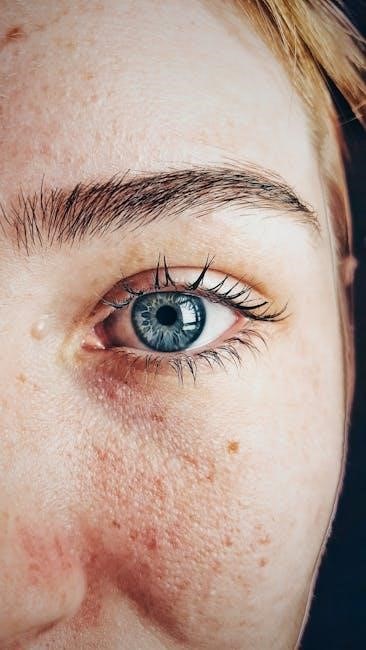Overview of Toni Morrison’s “The Bluest Eye”
Toni Morrison’s debut novel, “The Bluest Eye,” published in 1970, explores themes of race, beauty, and identity through the tragic story of Pecola Breedlove․ Set in Ohio, it critiques destructive beauty standards prevalent in society․

Plot Summary of “The Bluest Eye”
“The Bluest Eye” unfolds in Lorain, Ohio, during the 1940s, centering on Pecola Breedlove, a young African American girl who yearns for blue eyes, believing they will make her beautiful and loved․ The novel is narrated through the eyes of Claudia MacTeer, a childhood friend, and an omniscient narrator, offering multiple perspectives on Pecola’s tragic life․ Pecola endures neglect, abuse, and the corrosive effects of internalized racism․
Her family, the Breedloves, are deeply dysfunctional, contributing to Pecola’s feelings of worthlessness․ She is raped by her father, Cholly, an event that shatters her already fragile psyche․ Pecola descends into madness, convinced that she finally possesses blue eyes, granted to her by Soaphead Church, a charlatan․ The novel explores the devastating impact of white beauty standards on young black girls, highlighting how societal prejudices can destroy individual lives․
Character Analysis: Pecola Breedlove
Pecola Breedlove, the central figure in “The Bluest Eye,” embodies the devastating consequences of internalized racism and societal beauty standards․ Growing up in a dysfunctional family marked by poverty and abuse, Pecola internalizes the belief that she is ugly and unworthy of love․ Her dark skin and perceived unattractiveness become sources of deep shame and insecurity, fueling her desperate desire for blue eyes, which she equates with beauty and acceptance․
Pecola’s vulnerability makes her a target for the cruelty of others, further reinforcing her negative self-image․ The rape she endures at the hands of her father, Cholly, shatters her fragile psyche, leading to her eventual descent into madness․ Pecola’s character serves as a powerful indictment of the destructive power of racism and the importance of self-love and acceptance․
Themes of Race, Beauty, and Identity
“The Bluest Eye” intricately explores race, beauty, and identity, showcasing how societal standards impact self-perception, particularly for young Black girls like Pecola, who internalize harmful ideals leading to tragic consequences․
The Impact of White Beauty Standards
Morrison’s “The Bluest Eye” deeply explores the devastating impact of white beauty standards on the self-esteem and identity of young Black girls․ The novel highlights how pervasive images of white femininity, often presented as the epitome of beauty, contribute to feelings of inadequacy and self-loathing among those who do not fit this narrow mold․ Pecola Breedlove’s tragic yearning for blue eyes symbolizes the internalization of these damaging standards, leading her to believe that possessing white features would make her worthy of love and acceptance․ The narrative showcases how these externally imposed ideals can warp self-perception and contribute to psychological distress and societal marginalization․ The characters’ struggles reveal the profound and lasting consequences of a society that equates beauty with whiteness, ultimately leading to the destruction of individual and collective identity․ This constant comparison fosters a sense of inferiority, perpetuating cycles of self-hatred and hindering the development of positive self-image․
Internalized Racism
“The Bluest Eye” powerfully portrays the insidious nature of internalized racism within the African American community․ Characters internalize white societal values, leading them to devalue their own Blackness․ Pecola Breedlove’s longing for blue eyes exemplifies this phenomenon; she believes possessing white features would make her beautiful and worthy of love․ This desire reflects the deep-seated belief that whiteness is superior․ Pauline Breedlove also embodies internalized racism by favoring white beauty standards and neglecting her own appearance, further reinforcing the idea that Blackness is unattractive․ The novel illustrates how pervasive racism leads to self-hatred and the perpetuation of harmful stereotypes within the community․ This internalized oppression manifests in various forms of self-destructive behavior, impacting relationships and overall well-being․ Morrison highlights the psychological damage caused by constantly measuring oneself against unattainable white ideals․ Through these characters, she exposes the devastating consequences of internalizing racist beliefs, ultimately hindering self-acceptance and community solidarity․

Narrative Structure and Voice
“The Bluest Eye” employs a fragmented narrative, interwoven with distinct voices․ Claudia MacTeer’s perspective, combined with an omniscient narrator, reveals the tragic story of Pecola and the destructive impact of societal ideals․
Non-Chronological Storytelling
The narrative of “The Bluest Eye” deliberately avoids a linear, chronological progression․ Instead, Morrison employs a fragmented structure, weaving together past and present, memories, and perspectives․ This non-chronological approach reflects the fractured nature of Pecola’s experiences and the disruption caused by trauma․ The story unfolds through thematic associations and emotional resonances, rather than a strict timeline․ Events are linked by the narrators’ voices and memories, creating a complex and layered understanding of the characters and their circumstances․ This technique mirrors the way memories surface and influence our perception of reality, emphasizing the lasting impact of the past on the present․ The scattered narrative invites the reader to piece together the puzzle of Pecola’s life, engaging them in the process of understanding the root causes of her tragedy․
Dual Narrators: Claudia MacTeer and an Omniscient Voice
“The Bluest Eye” employs a dual narrative structure, alternating between the perspectives of Claudia MacTeer, a young Black girl, and an omniscient, almost Greek chorus-like, voice․ Claudia’s narration provides a child’s perspective on the events, offering an intimate and subjective account of Pecola’s life and the community’s reactions to her․ Her youthful innocence contrasts sharply with the harsh realities she witnesses․ Conversely, the omniscient narrator provides a broader, more detached view, offering historical context and societal analysis․ This voice often speaks in a poetic and lyrical style, reflecting on the systemic issues of racism and internalized oppression that contribute to Pecola’s tragedy․ By juxtaposing these two distinct narrative voices, Morrison creates a multifaceted and nuanced portrayal of Pecola’s world․ The combined perspectives enrich the reader’s understanding, unveiling both the personal and the societal forces at play․

Critical Reception and Challenges
Initially met with mixed reviews and commercial struggles, “The Bluest Eye” later gained acclaim for its exploration of race, beauty, and the damaging effects of societal prejudice․
Initial Reception and Later Acclaim
Upon its initial publication, “The Bluest Eye” experienced a somewhat lukewarm reception․ While some critics recognized Morrison’s talent, the novel did not achieve widespread commercial success early on․ However, as time passed, more reviews and analyses were written in praise of Morrison’s writing․ Critics began to appreciate her exploration of the colonization of the mind and her powerful critique of societal prejudices․ The novel’s significance in ongoing discussions about race, beauty standards, and their enduring consequences became increasingly recognized․ This shift led to later acclaim and solidified “The Bluest Eye” as a significant work in American literature․
Controversy and Challenges to the Book
“The Bluest Eye” has faced considerable controversy and challenges, often appearing on lists of frequently challenged books․ Its themes of racism, child abuse, and sexual violence have sparked debate and led to attempts to remove it from school curricula and library shelves․ Some critics argue that the novel’s explicit content is inappropriate for younger readers, while others defend its literary merit and its importance in addressing difficult social issues․ Despite these challenges, “The Bluest Eye” remains a significant work, prompting ongoing discussions about censorship, representation, and the power of literature to confront uncomfortable truths․
Literary Analysis and Interpretation
Literary analysis of “The Bluest Eye” reveals Morrison’s masterful use of symbolism and language․ The novel intricately explores themes of race, identity, and beauty through compelling narrative and character development․
Symbolism in “The Bluest Eye”
“The Bluest Eye” is rich with symbolism, most notably the symbolic significance of blue eyes․ Pecola’s desire for blue eyes represents her yearning for acceptance and beauty within a society that equates whiteness with these ideals․ The marigolds, planted by Claudia and Frieda, symbolize the potential for growth and beauty even in harsh conditions, mirroring Pecola’s own stunted development․ The Breedlove family’s dilapidated house symbolizes their poverty and social marginalization, reflecting their broken lives and the systemic forces that oppress them․ Furthermore, the candy, Mary Janes, represent the allure and false promises of white culture, which are ultimately unattainable and destructive for Pecola․ The novel’s fragmented narrative structure also symbolizes the fractured nature of Pecola’s psyche and the distorted reality she inhabits․ These symbols amplify the novel’s themes of racial identity, internalized racism, and the devastating impact of societal prejudice on vulnerable individuals․
Morrison’s Writing Style and Language
Toni Morrison’s writing style in “The Bluest Eye” is characterized by its lyrical prose, vivid imagery, and powerful use of language to explore complex themes․ She employs a distinctive narrative voice that blends the perspectives of Claudia MacTeer with an omniscient narrator, creating a multi-layered and emotionally resonant story․ Morrison’s use of African American Vernacular English (AAVE) adds authenticity and depth to her characters, reflecting their cultural identity and experiences․ Her writing is also notable for its unflinching portrayal of difficult subjects such as racism, abuse, and trauma, which she approaches with both sensitivity and honesty․ Furthermore, Morrison’s use of symbolism and metaphor enriches the text, inviting readers to engage with the novel on multiple levels․ Her evocative descriptions of setting and character contribute to the novel’s immersive quality, drawing readers into the world of Pecola Breedlove and the MacTeer family․

Adaptations of “The Bluest Eye”
“The Bluest Eye” has been adapted into a stage play by Lydia R․ Diamond, premiering in 2005․ The adaptation brings Morrison’s powerful story to a new medium, exploring its complex themes․
Stage Play Adaptation by Lydia R․ Diamond
Lydia R․ Diamond adapted “The Bluest Eye” into a stage play, premiering in 2005․ This adaptation provides a different lens through which to examine Morrison’s powerful narrative․ Diamond’s adaptation brings the characters and their struggles to life in a new, visceral way, allowing audiences to connect with the story on a deeper level․
The play retains the core themes of race, beauty standards, and the impact of prejudice, while also exploring the complexities of family dynamics and the search for identity․ By adapting the novel for the stage, Diamond amplifies the emotional impact of the story and makes it accessible to a broader audience․ The adaptation has been praised for its faithfulness to the source material and its ability to capture the essence of Morrison’s writing․
